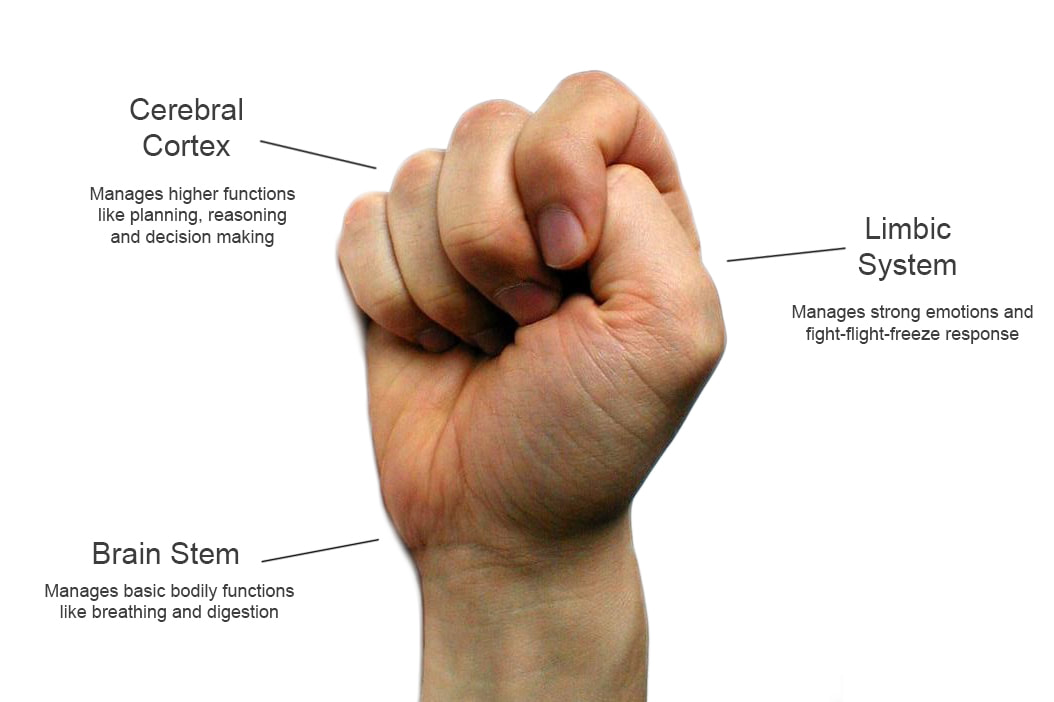|
Did you know that when you feel overwhelmed, fearful or extremely stressed, part of your brain literally shuts down? It’s true. The cerebral cortex can actually go offline, which leaves you in fight-flight-freeze mode. That’s a good thing if you’re in a dangerous situation and you need to quickly get to safety. But it’s not such a good thing when you’re in a situation where the fight-flight-freeze response either doesn’t make sense or where it isn’t possible to fight, flee or freeze up. Like when you’re in a stressful situation at work or having a disagreement with a family member. How Fight-Flight-Freeze Works Human brains are made up of three main sections - the brain stem, the limbic system and the cerebral cortex. If you make a fist with your thumb tucked inside your palm, your wrist and palm would be the brain stem, your thumb would be the limbic system and your fingers would be the cerebral cortex. The brain stem is the oldest and most basic part of the brain. It handles things like breathing, digesting food and eliminating waste - all the basic bodily functions required to live. The limbic system is the emotional center of the brain. It’s where we process strong emotions and where the fight-flight-freeze response gets activated when our emotions are overwhelming. It was designed to activate this response because the dangers of living in caveman times (sabertooth tigers, hostile tribes, etc.) required us to have an automatic response that would quickly get us out of danger and ensure our survival. Super handy when a wooly mammoth is trying to stomp you into the ground. Not so handy when you’re in the middle of the grocery store. The cerebral cortex is the newest, wisest part of the brain. It handles things like planning, decision making and reasoning. This part of the brain isn’t fully developed until we’re in our mid-20s, which is why teenagers do seemingly crazy things like driving recklessly and binge drinking. The logical part of their brains just isn’t finished growing yet. Putting it all together, when all goes well, the cerebral cortex will process any given situation, allowing you to respond in a rational, appropriate manner. But when things feel overwhelming, the brain goes into red alert. It shuts off the cerebral cortex, leaving the limbic system to figure out the best way to survive - fight, flight or freeze. Grounding Techniques for Calming Down Now that we’re no longer living in caveman times, this response can happen at inopportune times. Like during a meeting with your boss or maybe when you simply think about a stressful situation from your past. This is super common. It’s also super common to feel powerless in these situations. Like you have no control and are about to either explode or collapse. But you have the power to bring the cerebral cortex back online so that you can get back into a calm, rational state of mind. How? By using grounding techniques. These are simple, biological techniques for regulating your brain so that you can calm yourself, rationally think through the situation and respond appropriately. 1. Become Aware of Your Body Bring yourself back into your body and out of fight-flight-freeze mode by focusing on the sensations in various parts of your body. Here are a few ways to do that.
2. Breathe There are tons of breathing exercises, but these are the two most commonly used for calming down. If they don’t work for you, don’t worry. You can find a lot more options on this list.
3. List It List as many things as you can think of in a particular category. These are a few example categories, but feel free to make up your own. If you get stuck, move on to another category. Animals Movies Countries Cereals Fruits Vegetables TV shows Cities Colors Cars Flowers Trees 4. Describe It There are a few different ways to do this one:
5. Use Your Senses with 5-4-3-2-1 Focusing on your five senses is a great way to ground yourself in the present. To do this, list five things you can see, four things you can feel, three things you can hear, two things you can smell and one thing you can taste. 6. Get Physical There are a million ways to get physical, even if you don’t have much time or space. Here are a few ideas.
7. Meditate
You can do this any time, anywhere. Just find a nice spot to sit and try to view your thoughts as clouds passing by the blue background of your calm, clear mind. Whenever you notice a thought, say hi to it and then watch it slowly sail by. You can also do guided meditations. There are lots of free apps that offer them (Insight Timer is a good option). There are also tons of great guided meditations on this website. 8. Get Creative Even if you’ve never thought of yourself as an artist, you can still do creative things to bring you back into the present. Try one of these options.
9. Watch Relaxing or Funny Videos Nature videos are great for relaxation, especially when it’s too dreary to go outside and enjoy actual nature. If you feel like you need a laugh, find some funny dog videos. Youtube has videos of every type. 10. Call or Text Someone Go ahead and make a list of all the people in your life that you can contact at any given time, even if it’s just to say hi or to share a funny meme. Next time you feel overwhelmed, get out your list and start contacting people. Connecting with others is a great way to feel more safe and grounded. Conclusion If you struggle with grounding or calming yourself during stressful situations, print this list and carry it with you or post it where you can see it regularly or bookmark it in your phone. Next time you feel that fight-flight-freeze response, look at the list and pick any one of these grounding techniques to bring yourself back into a calm state of mind. A therapist can help you work through the deeper issues that might be causing your fight-flight-freeze response. Don’t let financial barriers hold you back from getting the help you deserve. Contact Psychology for All for more information about our free therapy services. Licensed clinicians from our provider network can help you with understanding various ways to cope amidst overwhelming circumstances. The first step is filling out our application packet.
0 Comments
Leave a Reply. |
AuthorWrite something about yourself. No need to be fancy, just an overview. Archives
June 2024
Categories |




 RSS Feed
RSS Feed
